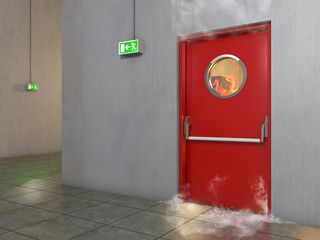Fire Prevention Month - Preventive Measures And Exit Panic Devices
Living & Lifestyle5 minutes read
1785 views
1785 views
(Guest Writer: Rosette Monell)

Source of image: Pinterest
Fires are the leading cause of home injury and death. Other regions aside from The Americas, Western Europe, East Asia, and Oceania have two to six deaths caused by fire per 100,000 people, while cooking is the primary cause of home fires. Hence why safety precautions have been implemented globally to further reduce the number of fire incidents.
One of the popular government campaigns that address this issue worldwide is Fire Prevention Month. During this time of the year, the public is encouraged to be more vigilant against compromising their safety during fire-related accidents.
Promoting fire preventive measures and educating the public on hazard assessment and what to do during a fire is prioritized. After all, the safest way to deal with fire is still prevention.
With that in mind, here are some basic fire preventive measures, fire detection tips, and emergency options that you should know coming into Fire Prevention Month.
1. The Fire Prevention Triangle
A fire needs three elements: heat, oxygen, and fuel. A fire will neither start nor spread if these are absent. Therefore, a key strategy in fire prevention is properly assessing the risk of exposing flammable materials to these elements.
Heat is generated by work processes and must be dealt with properly. At home, control sources of ignition such as gas stoves and make sure that the food you are cooking doesn’t go unattended. Also, ensure that flammable materials are nowhere near smoking areas. For equipment at work, be sure that they are protected from catching fire and overheating.
Pure oxygen at high pressure reacts violently with common materials like grease. If you’re working in an area exposed to equipment that uses oxygen, have the place checked for adequate ventilation and always handle oxygen equipment with care.
As for fuel, it’s all about storage and handling. Make sure that the storage equipment that you are using is made for containing flammable liquids and keep them away from ignitable materials.
2. Emergency Escape
Security should never take precedence over safety. Luckily nowadays, there is hardware that can take care of both, such as the exit panic device which allows doors on escape routes to be used without the need for a key.
Regardless of the size of the premises are, employers and landlords must evaluate the evacuation routes when considering escape options. All routes must be clear of any obstructions, including the areas outside the premises. The number of occupants and people with disabilities should also be taken into account when mapping out the escape routes. Make sure that everyone can access them.
3. Fire Detection
Last but not least, installing an effective and reliable automatic fire detection and alarm system can spell the difference between saving yourself and preventing further damage to property. You can consult experts and fire authorities on which system to install at your property to avoid unnecessary costs. A smoke detector and a fire alarm are must-haves, together with manual points positioned at exit routes and adjacent to final exits.

Author’s Bio:
Rosette has a knack for anything DIY. She spent her younger years learning about the different hardware tools and equipment in the hopes of establishing a hardware business in the future. Her career options may have changed, but today, she continues to write so passionately about her first love.
Request for quotes and we'll match you with a selection of Interior Designers!
Previous
Chromesthesia Décor - Living Room Colour Palettes Inspired By 10 Music Genres


 Sign Up with Google
Sign Up with Google

.jpg)

